
Mail orders: 01702 684444
Southend main office: for all mail order sales, Southend area demonstrations, pre sales info and post sales support.42-46 Queens Road, Southend SS1 1NL.
Open Mon-Sat 10AM to 5PM (Sat sales only).
Batteries for Woosh electric bikes
All modern Lithium batteries can last about 5 years and can be recharged up to 800 times.
Recommendations:
- The more you use your bike, the stronger is the battery.
- Don't charge your battery too often, you only have 800 cycles. Wait until you use at least 1 or 2 bars out of 5.
- Buy a new battery every 5 years. Technology improves every year, it's worth it.
Storage:
1. If you don't need your battery for a few months, do not keep the battery full, it will degrade faster if kept full or flat.
Ride the bike until you use at least one bar out of 5 before storing.
2. Keep the battery on your bike.
3. Keep the bike in your garage, out of humidity and direct sunlight.
New! Bag batteries
There is no lock and key on the bag batteries.
The ouput connectors are the red and black Andersons, they need very low insertion force and produce virtually no spark.
The charging port is the yellow XT connectors, they need low insertion force and produce virtually no spark.
Their chargers have matching connectors, so there is no danger of connecting wrongly in the dark or rain.
The battery is supplied with an extension lead, to connect Andersons to bullets for your motor.
If you want to secure it to the bike frame, run a steel loop around the connectors and attach the loop to the frame.
The saddle bag is made by Rockbros or Wildman you can replace it easily if you want to.
You get about 50 miles range with the 48V 10AH and 36V 15AH bag batteries like this one below.
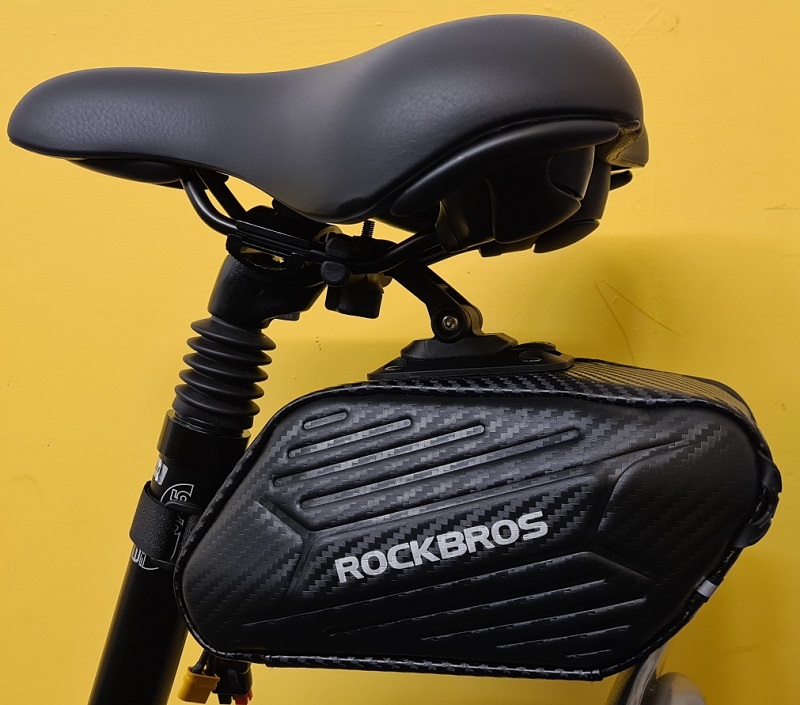
Battery prices
| Bag battery | Battery | Charger | Cradle/Rack | Complete kit |
| New 36V10AH bag 21700 cells for Q70 kits | £179 | £29 | £208 | |
| New 48V10AH bag 21700 cells for BBS01ET/TSDZ2 | £219 | £29 | £248 | |
| New 36V15AH bag 21700 cells for BBS01B | £229 | £29 | £258 | |
| Downtube battery | Battery | Charger | Cradle/Rack | Complete kit |
| New DP2170 48V 15AH downtube for TSDZ2 | £300 | £29 | £11 | £340 |
| New DP2170 36V 20AH downtube for BBS01 | £300 | £29 | £11 | £340 |
| HL 36V13AH downtube | £250 | £29 | £11 | £290 |
| HL 36V15AH downtube | £270 | £29 | £11 | £310 |
| HL 48V12AH downtube | £300 | £29 | £11 | £340 |
| HL 36V17AH downtube | £320 | £29 | £11 | £360 |
| Rack battery | Battery | Charger | Cradle/Rack | Complete kit |
| 36V17AH rack | £300 | £29 | £25 | £354 |
| New 36V20AH rack 21700 cells | £300 | £29 | £25 | £354 |
| 48V12AH rack | £300 | £29 | £25 | £354 |
| New 48V15AH rack 21700 cells | £300 | £29 | £25 | £354 |
| 36V13AH smallfrog | £250 | £29 | £279 |
Battery for other brands
It is very difficult to supply batteries for bikes that do not come from us.Firstly, although they may look the same, the plastic housing in which batteries are installed varies from bike to bike and brand to brand, so it is likely that our battery will physically not fit your bike.
Secondly, our suppliers ask that we must sell you a charger with one of our batteries as other chargers may damage the battery.
If we sell you a battery it is on condition that we also sell you a charger (£29) and without guarantee.
Please email us or send us your enquiry via our web page.
Battery enquiry
Replacement batteries:
Battery for Woosh Gale and Sant Ana with keylock
3.5 kgs, 36 Volts 14.5 AH (Amp Hours) (Lithium Ioan)
Price including VAT: £319 (including p&p)
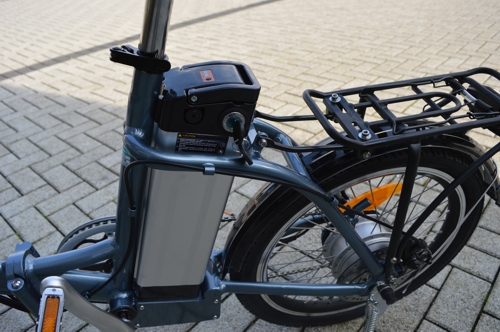
1.5 kgs, 36 Volts 7.5 Amp Hours
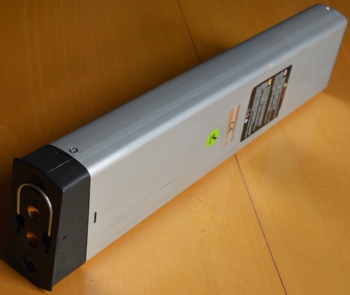
Price including VAT: £199 (including p&p)
Battery for 20" Zephyr (2 parts) and Zephyr CD
3.5 kgs, 36 Volts 8 Amp Hours (Lithium)
Price including VAT: £245 (including p&p)
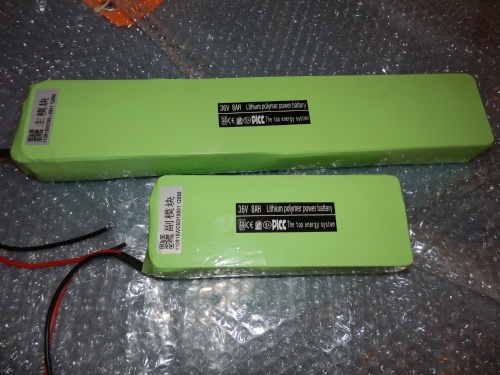 Now replaced by one part battery
Now replaced by one part battery
Battery for Woosh Zephyr-B with keylock
2 kgs, 36 Volts 10 Amp Hours (Lithium)
Price including delivery £255
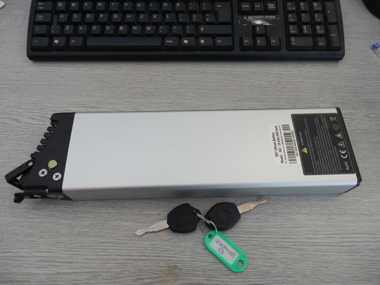
Battery for Big Bear and Santana-CD with keylock
4.3 kgs, 36 Volts 15AH
Price including VAT: £369 (including p&p)
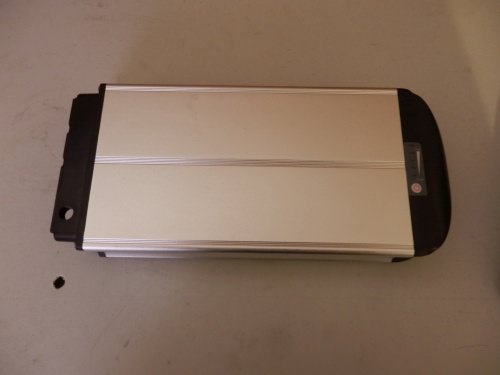
Battery for Big Bear and Santana-CD with keylock
4.3 kgs, 36 Volts 17AH
Price including VAT: £409 (including p&p)
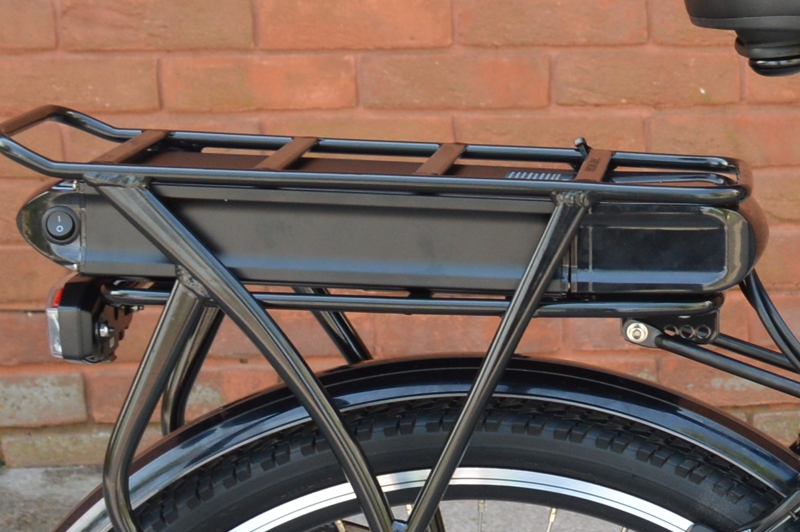
Intelligent chargers
For 36V Lithium ion batteries, output 42V 2A max.
Various models with different connectors (3-pin XLR, large RCA plug type, laptop co-axial plug type).
With mains lead and UK plug.
Price including VAT: £33 (including p&p)
Picture.
Maintenance of batteries
In a lithium-ion battery, Lithium ions move from the positive electrode to the negative electrode when charging and vice versa when you ride your bike. In theory such a mechanism should work forever, but in practice, your battery will age with time and repeated charging cycles. To get the best out of your battery, follow the recommendations below:- Use your battery regularly. Ride your bike as often as you can.
- Don't charge up after every short trips, wait for the battery to go down a bit, best time to charge is when the battery is half full.
- Grease the battery contacts and sliding rails if you have a rack battery.
- Avoid extreme temperatures. Your battery will work between 0oC and 60oC but it's best to keep it at room temperature, between 15oC and 25oC.
- Avoid shocks, very bumpy roads and pot holes.
- Avoid humidity.
Your battery contains a lot of electronic components besides the Lithium-ion cells, humidity will oxydize the copper on the circuit board like it would your copper pipes. Keep your battery dry. If you ride in the rain, give your battery a wipe when you come home.
- If you cannot ride your bike in the winter months:
a) If your battery has an on/off switch, switch it off in winter months.
b) Every 2 months, switch it on and check the battery level.
If still full, give it 10 minutes top up charge.
If one LED has gone off, give it a 30 minutes top up charge.
When well used and maintained, your battery should be good for about 500-700 charging cycles or 4 to 7 years.
Battery kits
Please note charger currently has UK socket. We cannot sell fitting kit on its own.Weight: typically 3.1kgs, colour: matt Black.
New DP2170 batteries
These are slighly larger downtube batteries (DP2170: 368mm L x 103mm H x 95mm W, HL: 361mmL x 92mmH x 90mmW). They are fitted with larger 5000mAH Panasonic 21700 cells.
They give about 18% more capacity for virtually the same price compared to 18650 Panasonic cells.
They are supplied with our CD kits, BBS01 and TSDZ2 at the moment. We don't have DP controllers for our hub kits yet
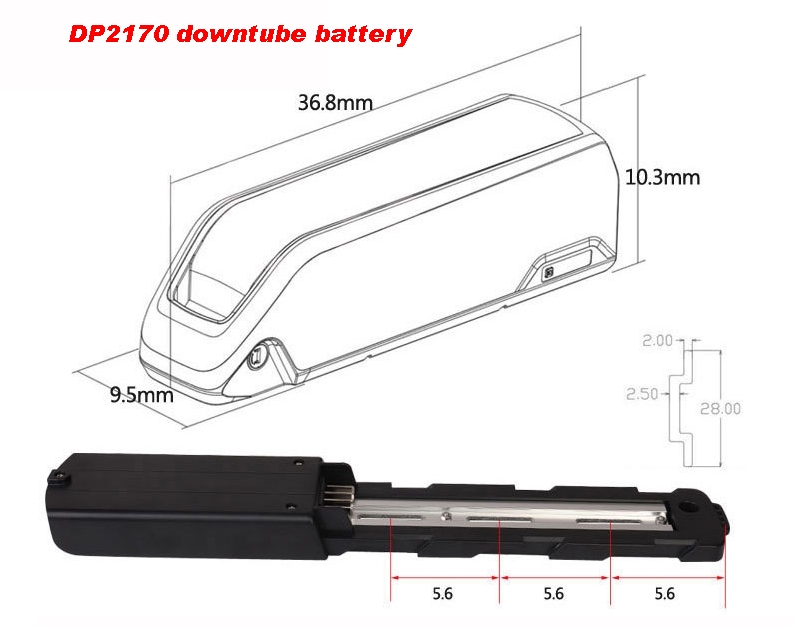
Installation
To avoid fouling against the chainring on some bikes, it's best to mount the battery in the middle of the downtube: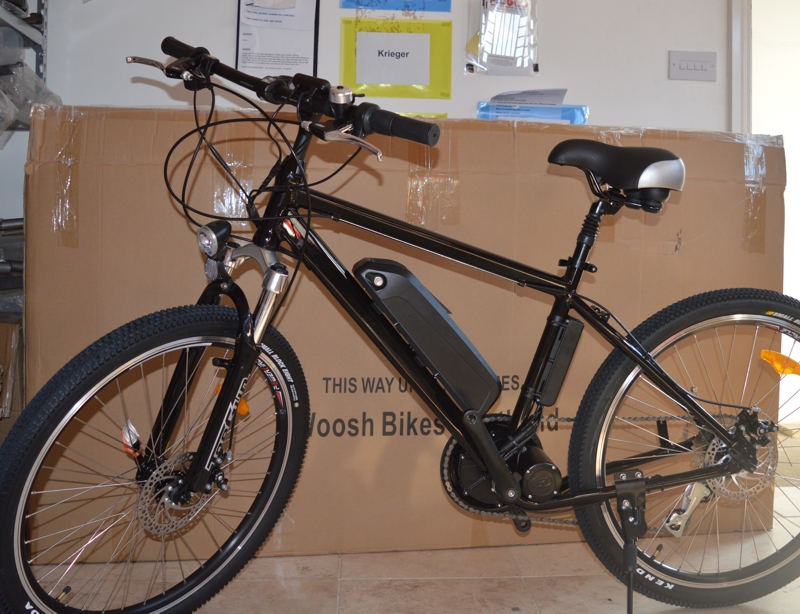
You should check your frame for space and location of the cage bolts before ordering.
- best position for the battery is in the middle of the downtube.
- you may need to drill extra holes on the mounting rail to suit your downtube.
- if the location of your cage bolts do not fit the slots on the mounting rail, you may need to install one or two rivnuts (usually M5 rivnuts) on the downtube.
You don't need any special tool but if you have never done this before, Read this article.
Or watch this video: https://www.youtube.com/watch?v=qNLo2rIw5M8
In the example below, our bottle cage bushes did not make the job easy.
We have drilled one extra hole in the aluminium base for the bottom right bolt and fit an M5 rivnut to fit the top left bolt:
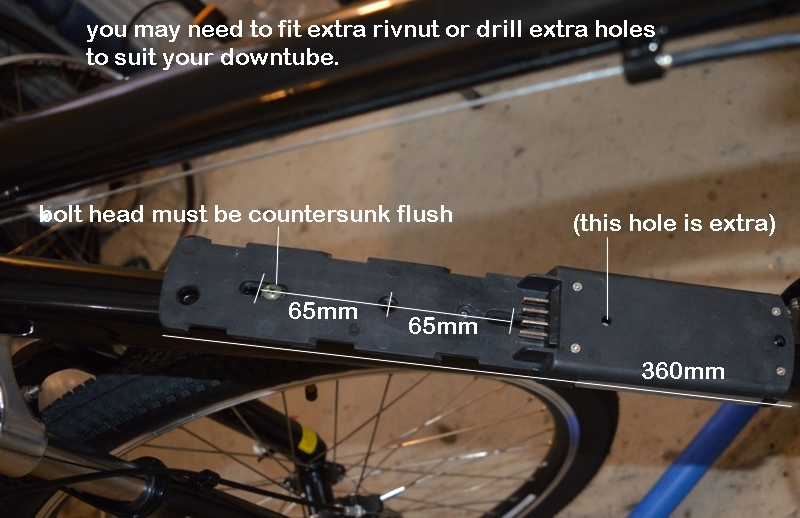
Here the HL battery is used with our GSM CD kit:
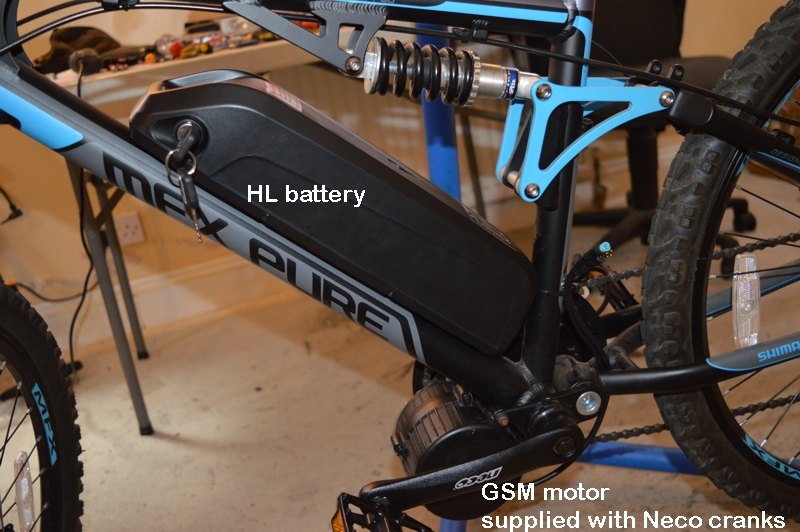
Dimensions: 361 x 90 x 92 (in mm L x W x H)
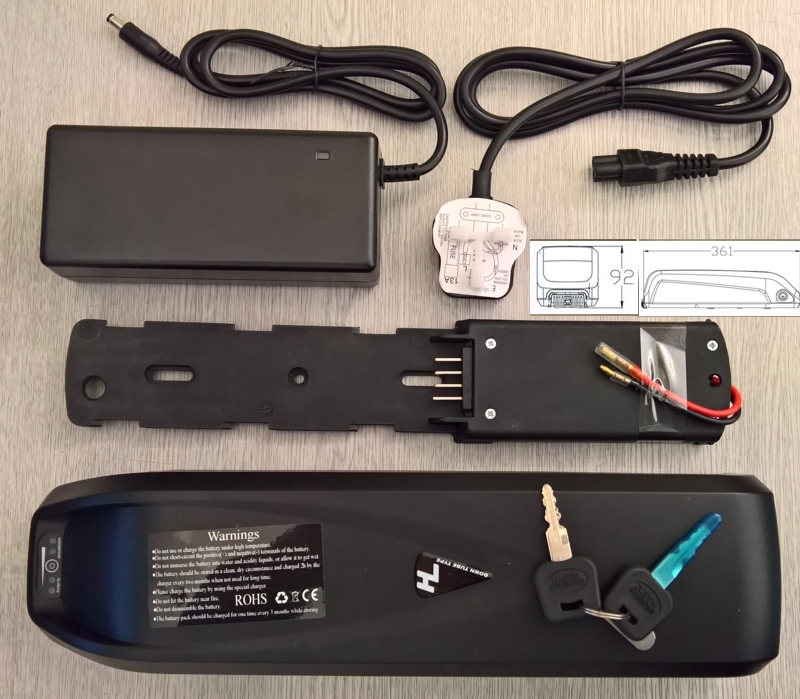
Small Frog battery
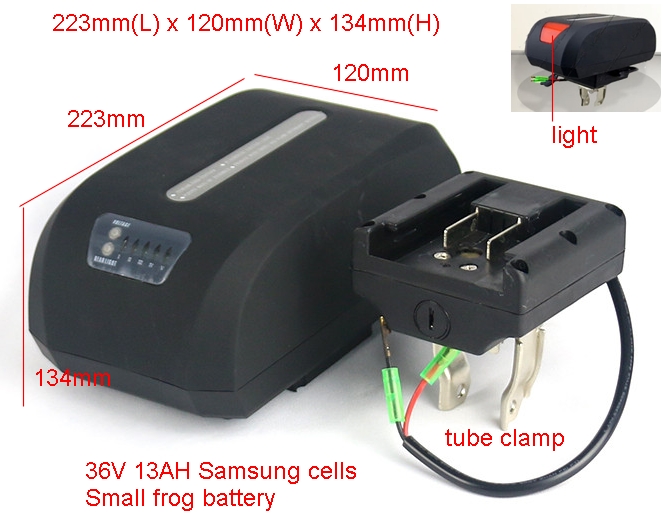
| Dimensions | LWH: 223mm x 120mm x 134mm |
| Light | red, with on/off switch |
| On/off button | yes |
| Fitting | supplied with tube clamp (4cm-5cm in diameter) Can be modified to suit other situations |
| Lock | yes, supplied with 2 keys |
| Capacity | 36V x 13AH (468WH)|
| Battery cells | Samsung |
| Terminals | standard red (36V) and black (ground) wires with 3.9mm bullet crimps |
| Weight | 2.64kgs battery, 180g clamp and mounting base. |
| Applications | Will suit BBS01B kit and torque sensor hub kits. |
| Price | £319. |
How to mount the small frog battery to the seat pin:
You'll need a seat post clamp with rackmount:
(Where where to get it?)
Bolt the tube clamp to the rack mount with two M5 bolts.
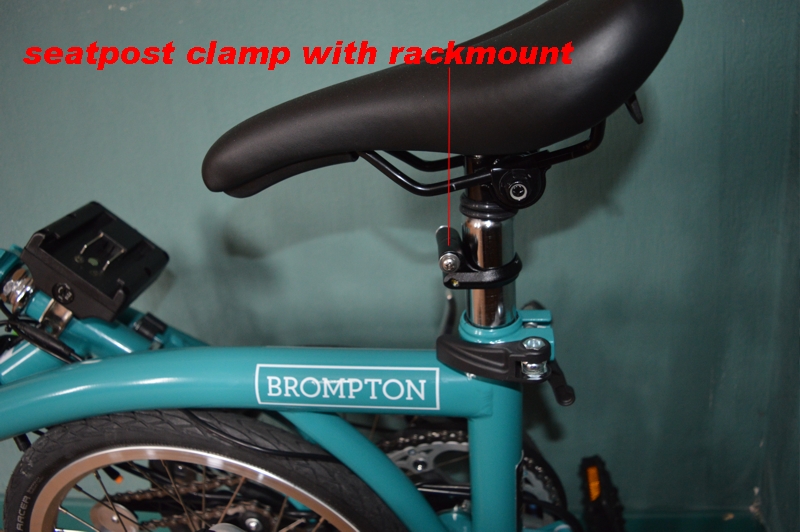
Frequently asked questions about e-bike batteries
What are the differences between Lithium polymers (Lipos) , Lithium-ions (Li-ions) and iron phosphate?
Lithium ion is the general category (we just call them lithium batteries), Lithium polymer another name for Lithium ion batteries that are made into pouches and iron phosphate is a type of chemistry used to make Lithium ion.If you want to be precise, it is better to refer to the battery by their chemistry.
Virtually all current electric bike batteries use one of these two chemistries:
1) LiNiCoMnO2 (commonly called Lithium ion) and 2) LiFePO4 (Lithium iron phosphate).
The word LIPO is often used with two different meanings: the technology of making Lithium ion batteries and RC Lipo (popularized by hundreds of thousands of Hobby King customers).
RC Lipo is never used in our bikes because they are unsafe.
Lithium ion batteries are made by printing over a plastic film (hence the name polymer) with Lithium composite anode and cathode.
The process ends up with a 7-layer film only 15 micron thick (substrate, cathode tab, cathode, electrolyte, anode, anode tab, protection).
This film is then rolled up and packed into either soft pouch (prismatic cells used in our rear carrier batteries) or cylinders (eg 18650 used in our bottle batteries).
About a quarter of the weight of your battery comes from Lithium metal, the rest is mainly plastic and other metals.
Which chemistry is better for electric bikes?
Lithium iron phosphate has a flatter discharge profile but heavier.We think Lithium ion (LiNiCoMnO2) is now the clear winner because it's lighter.
However, it's the quality of the cells used in your battery that makes all the difference.
What do you mean by C?
C is the capacity of your battery. It's the 10A in 36V 10AH for example.What is the maximum continuous discharge rate?
This is given usually as 1C to 1.5C, for a 36V 10AH, that means between 10A and 15A.For a short period, Lithium-ion cells will sustain 3C and iron phosphate will sustain 5C.
This is not very useful information because firstly, there is a 30A fuse on the output and secondly the controller will limit the current to 14A.
What do you mean by CC and CV?
These are charging methods, CC = constant current, CV constant voltage.The chargers are smart, you must always use the right charger that comes with your bike and battery.
They usually have been programmed to charge the battery with the correct method.
Our batteries require contant current charging (CC) up to the programmed voltage (usually at 2A up to 40V for a 37V battery),
then gradually reduces the current while maintaining the specified voltage (CV) until the current drops to near zero.
During this period, the battery management system carries out the balancing, equalizing the charge between all its cells.
It may change from red to green a few times before finishing, during balancing.
Lithium-ion chargers are thus said to be CC/CV chargers
The charging light on the charger goes red when charging and green when charging is finished
What does the BMS do?
There are always small imbalances between cells because they are chemical devices.The BMS (battery management system) tries to balance the cells when charging and discharging.
Without the BMS, the battery will have a much shorter life and are dangerous to handle.
Should I run deep charge cycles?
No. This is not appropriate for modern batteries.What is conditioning a battery?
Woosh batteries do not need conditioning.
But if you still want to do this, charge it up to full before first use then run it to nearly flat but do not stress your battery too much
in the first few days (avoid hills) and put the battery back on charge every
night for a few nights.
Your battery works best between 95% and 20%. At either end of the spectrum, the
electrodes are stressed by swelling and may produce gases which damage their
structure so avoid stressing it if the battery level is already low.
What is the trickle current?
Your battery is a chemical device, it loses its charge through diffusion.The rate of natural discharge is called trickle current.
On modern batteries, this is around 3% per month but it's better to err on the side of caution, recharge your battery at least once every 2 months even without use.
Should I charge my battery every day?
Only if you ride every day.Put the battery on charge after you come back from a ride and switch off the charger (from the wall socket) after the charging light goes green.
Batteries like and need to be used. Use it or lose it.
Do you sell replacement batteries for other bikes than Woosh bikes?
In principle no but if your old battery is very similar then we can sell to you but without any warranty because we have no idea whether it'll fit or it'll work.We will still try to help you out if we can.
Do you sell replacement cells and BMS?
No. But we may if you can prove to us that you have the expertise.Image of BMS | Battery wiring diagram
Returning a Battery:
If you need to return your battery for any reason, you will need to pack it sufficiently well in a strong box with at least 2 inches of polystyrene and/or bubble-wrap all around.Not all couriers will carry batteries, so you may wish to use our courier, if this is the case, give us a call on 01702 4335566
Regardless of which carrier you use (ours or your own), you must print out and attach the two labels linked to below to the outside of the package.

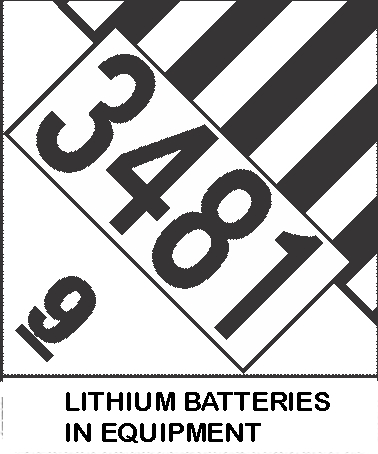
Popular cells and their chemistry
NCR-18650 3.6V 2900mAh LiNiCoAlO2
ICR18650 28A 3,75V 2800mAh LiCoO2
ICR18650 26F 3,7V 2600mAh LiNiMnCoO2
ICR18650-30A 3.78V 3000mAh LiCoO2
ICR18650-22P 3,6V 2150mAh LiNiMnCoO2
ICR18650 HA1 3,65V 1300mAh LiNiMnCoO2
ICR18650 HB2 3,65V 1500mAh LiNiMnCoO2
ICR18650B4 3,6V 2600mAh LiNiMnCoO2
NCR-18650E 3,6V 2250mAh LiNiCoAlO2
INR18650 20Q 3,6V 2000mAh LiNiMnCoO2
ICR18650 MF1 3,65V 2150mAh LiNiMnCoO2
INR 18650 29E 3,65V 2850mAh LiNiMnCoO2
NCR-18650B 3,6V 3350mAh LiNiCoAlO2
ICR 18650 MG1 3,6V 2850mAh LiNiMnCoO2
NCR-18650BF 3,6V 3350mAh LiNiCoAlO2
INR18650 MH1 3,7V 3200mAh LiNiMnCoO2
INR18650-25R5 3,64V 2550mAh LiNiMnCoO2
INR18650-25R6 3,64V 2550mAh LiNiMnCoO2
NCR-18650BL 3,6V 3350mAh LiNiCoAlO2
ICR18650 HE4 3,6V 2500mAh LiNiMnCoO2
INR18650-30Q 3,6V 2950mAh LiNiMnCoO2
INR18650 M26 3,65V 2600mAh LiNiMnCoO2
ICR18650-22F 3,6V 2200mAh LiNiMnCoO2